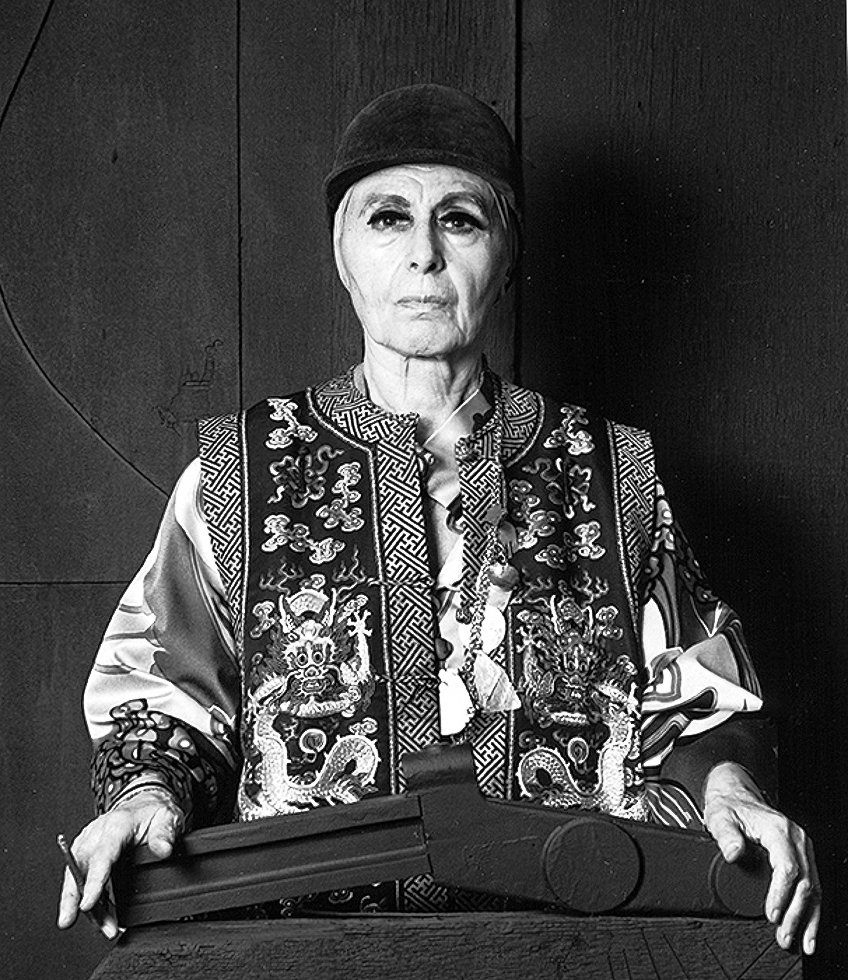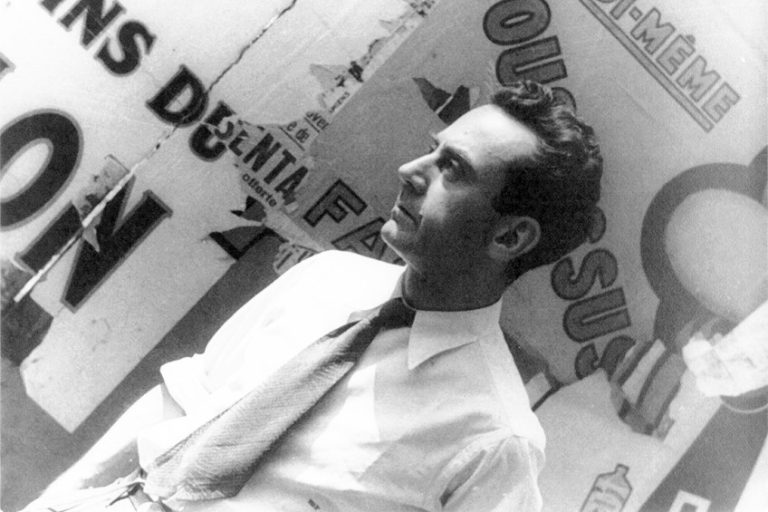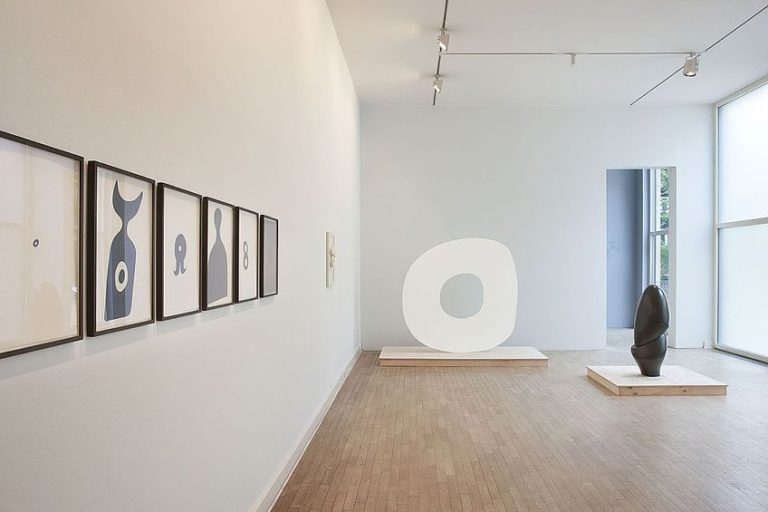Louise Nevelson – Sculpting Shadows and Light
In the captivating realm of modern art, Louise Nevelson’s biography stands as a testament to the indelible mark left by one of the 20th century’s most innovative sculptors. Louise Nevelson’s art transcends conventional boundaries, weaving a narrative that intertwines personal exploration with a profound engagement with form, space, and material. Renowned for her groundbreaking contributions to assemblage art, Nevelson’s creations invite viewers into a realm where disparate elements coalesce to form a harmonious whole. This article delves into the intricacies of Louise Nevelson’s art, unraveling the layers of her life and work to illuminate the brilliance of an artist who transformed discarded fragments into timeless masterpieces.
Louise Nevelson Biography: A Visionary in Assemblage Art
| Date of Birth | 23 September 1899 |
| Date of Death | 17 April 1988 |
| Place of Birth | Kiev, Ukraine (immigrated to the United States in 1905) |
| Nationality | American |
| Art Movement | Abstract Expressionism and Assemblage Art |
| Mediums Used | Wood, metal, and found objects |
| Famous Artworks |
|
Louise Nevelson emerged as a trailblazing force in the world of modern art. Her life’s narrative unfolds as a testament to resilience, creativity, and an unyielding commitment to pushing artistic boundaries. Nevelson’s biography is a captivating journey that traverses continents and decades, leaving an indelible mark on the art world. Louise Nevelson’s early years were marked by the turbulence of historical events. Born Leah Berliawsky, she grew up in Tsarist Russia and witnessed the tumultuous period of World War One. In 1905, seeking refuge from political and economic upheaval, her family emigrated to the United States, settling in Rockland, Maine.
It was in the small coastal town that Nevelson’s artistic sensibilities began to take shape.
Nevelson’s immersion into the world of art came gradually. After marrying Charles Nevelson in 1920 and relocating to New York City, she enrolled at the Art Students League, studying under the tutelage of influential artists such as Hans Hofmann (1880 – 1966). Her early works were predominantly figurative, reflecting the prevailing artistic trends of the time. However, it was during the 1930s, amidst the Great Depression, that Nevelson’s artistic voice started to grow.

Assemblage Art and the Black Period
The 1950s marked a transformative period in Nevelson’s artistic journey, as she delved into uncharted territories by experimenting with found objects. It was during this era that Nevelson’s sculptural collages began to take shape, providing a unique lens through which she could redefine the very essence of artistic creation. Nevelson’s assemblage art was characterized by her ingenious ability to repurpose discarded materials, breathing new life into objects that had lost their original utility. The artist’s fascination with the tactile and symbolic potential of these found items led her to create immersive, intricate compositions that beckoned viewers to engage with the layers of meaning embedded within her work. One of the most distinctive chapters in Nevelson’s artistic evolution is her renowned “Black Period,” a creative epoch that spanned from the late 1950s to the early 1960s.
During this period, Nevelson made a bold and deliberate choice: she exclusively employed the monochromatic richness of black for her sculptures.
This aesthetic decision was not merely an exploration of color but a deliberate strategy to elevate the formal elements of her creations. By restricting her palette to a single hue, Nevelson heightened the emphasis on form and texture within her sculptures. The use of black allowed her to transcend the limitations of color, encouraging viewers to focus on the interplay of light and shadow, the contours of each piece, and the overall spatial relationships within her compositions. This deliberate choice also bestowed a profound and mysterious quality upon her work, creating a visual language that transcended the ordinary and drew viewers into a realm of contemplation. The Black Period is a testament to Nevelson’s mastery in manipulating materials to evoke emotion and provoke thought.

Each sculpture became a play of contrasts, a dance between light and darkness, a visual symphony composed of disparate elements unified under the unifying banner of black. In this period, Nevelson’s creations transformed into enigmatic entities, inviting viewers to explore the depths of their own interpretations and connecting with the artist’s profound sense of artistic expression. Louise Nevelson’s Black Period is not just a chapter in her artistic journey; it is a testament to her fearless experimentation and unwavering commitment to pushing the boundaries of artistic expression. Through this period, she not only solidified her own place in art history but also laid the foundation for a new way of understanding and engaging with the world of assemblage art.
The legacy of Louise Nevelson’s Black Period continues to resonate, inspiring artists to embrace the transformative power of deliberate artistic choices in the pursuit of profound and mysterious beauty.
Famous Louise Nevelson Art Pieces
Louise Nevelson’s artistic legacy is marked by a series of iconic masterpieces that have left an enduring imprint on the world of contemporary art. These famous art pieces not only solidify Nevelson’s place in art history but also serve as enduring proof of her groundbreaking contributions to the world of assemblage art.
Let us look more closely at two of her sculptures.
Sky Cathedral (1958)
| Date | 1958 |
| Medium | Painted wood assemblage |
| Dimensions (cm) | 343.9 x 305.4 x 45.7 |
| Current Location | The Museum of Modern Art, New York City, United States |
Sky Cathedral, a masterful creation by Louise Nevelson in 1958, emerges as a captivating embodiment of her pioneering approach to assemblage art. This monumental sculpture, a testament to Nevelson’s unparalleled innovation, beckons observers into a realm where the ordinary transcends into the extraordinary. Composed of intricately arranged wooden fragments, Sky Cathedral is a symphony of forms, textures, and shadows that coalesce into a harmonious and captivating structure. Central to Nevelson’s artistic philosophy is her deliberate use of a monochromatic palette. The choice of a single color, in this case, black, transforms the disparate elements into a unified whole, accentuating the play of light and shadow. This intentional aesthetic strategy not only showcases Nevelson’s technical prowess but also imparts a timeless and contemplative quality to the sculpture.
The title, Sky Cathedral, adds another layer of significance to the artwork. It suggests a celestial structure, transcending the material realm and inviting viewers to contemplate the spiritual dimensions within the confines of the sculpture. Nevelson’s genius lies not only in her skillful arrangement of found objects but also in her ability to evoke a sense of reverence and awe, turning the sculpture into a contemplative sanctuary. Sky Cathedral stands as a testament to Nevelson’s mastery in manipulating space, form, and texture. As observers navigate the intricacies of the piece, they are drawn into a dialogue between the elements, experiencing a visual and tactile symphony that transcends the boundaries of conventional art. This iconic work remains a cornerstone of Nevelson’s legacy, inviting viewers to delve into the enigmatic beauty of her artistic expression and reflect on the transformative power of assemblage art.
Black Wall (1959)
| Date | 1959 |
| Medium | Assemblage of painted wood |
| Dimensions (cm) | 264,2 × 216,5 × 648 |
| Current Location | Tate Modern, London, United Kingdom |
Among Louise Nevelson’s most celebrated works is Black Wall, a monumental installation commissioned for the new Hall of Science at the 1959 New York World’s Fair. Comprising multiple large-scale assemblages, the piece showcased Nevelson’s mastery in transforming everyday objects into monumental expressions of beauty and complexity. Black Wall remains evidence of her ability to meld individual elements into a cohesive whole, blurring the lines between sculpture and environment. Black Wall is not merely a sculpture; it is an immersive experience that invites viewers into a realm where the boundaries between art and environment dissolve. Nevelson’s deft orchestration of form, texture, and scale creates a visual symphony that resonates with a profound sense of aesthetic unity. The monumental nature of Black Wall is immediately evident, both in its physical scale and conceptual depth.
Nevelson’s utilization of everyday objects, ranging from discarded wood and furniture fragments to assorted industrial elements, becomes a testament to her transformative vision.
Through meticulous arrangement and juxtaposition, she transcends the ordinary, imbuing each element with new meaning and context within the larger composition. The immersive quality of Black Wall is enhanced by Nevelson’s strategic use of her signature monochromatic palette, reminiscent of her iconic Black Period. The deliberate choice of a single color enhances the sense of unity and cohesiveness throughout the installation. The play of shadows and highlights on the black surfaces creates a dynamic visual rhythm, adding an element of temporal variability as lighting conditions change. Nevelson’s ability to meld individual elements into a cohesive whole is a hallmark of her artistic genius, and Black Wall epitomizes this skill.
As one navigates the labyrinthine contours of the installation, the boundaries between individual components blur, and the viewer becomes a participant in the unfolding narrative of form and shadow. The interaction between the sculptural elements and the surrounding space challenges traditional notions of sculpture, turning the entire environment into a canvas for Nevelson’s artistic expression. Black Wall is a symphony of contradictions—monumental yet intricate, complex yet harmonious, static yet dynamic. Nevelson’s deliberate blurring of the lines between sculpture and environment invites contemplation on the nature of artistic boundaries. The installation is a testament to the transformative power of art to transcend the mundane and elevate the ordinary into the realm of the extraordinary. In Black Wall, Louise Nevelson leaves behind a monumental legacy that continues to resonate with viewers, inspiring contemplation on the enduring power of artistic vision.
This immersive journey through her world of assemblage reaffirms Nevelson’s status as a trailblazer, challenging the conventions of sculpture and inviting us to explore the profound beauty that emerges when individual elements are seamlessly woven into a cohesive whole.
Recognition and Legacy: Louise Nevelson’s Enduring Impact
As Louise Nevelson’s artistic prowess blossomed, so did the recognition of her transformative contributions to the art world. Her work found a revered place in major museums and collections worldwide. Institutions such as the Museum of Modern Art (MoMA), the Whitney Museum of American Art, and the Tate Modern proudly showcase Nevelson’s iconic sculptures, ensuring that her legacy continues to be celebrated and studied by audiences across the globe.

Yet, Louise Nevelson’s legacy transcends the mere physical placement of her sculptures in esteemed institutions. Her influence resonates in a broader social and cultural context. Nevelson, as a woman breaking ground in the male-dominated art scene of her time, shattered gender norms with her unapologetic pursuit of artistic expression. Through her tenacity and artistic vision, she paved the way for future generations of female artists, empowering them to command their space and contribute significantly to the evolving tapestry of art history.
In conclusion, the tapestry of Louise Nevelson’s biography is intricately woven with threads of resilience, creativity, and unyielding artistic vision. As we journeyed through the chapters of her life, it became evident that Nevelson’s art transcends mere sculpture; it is a profound exploration of form, texture, and the transformative power of assemblage. From her early years marked by immigration to the United States to her groundbreaking Black Period and the monumental legacy of works like the Black Wall, Nevelson’s art is a testament to the enduring impact of a visionary in the world of modern sculpture. Through her unwavering commitment to pushing artistic boundaries, Louise Nevelson not only carved a space for herself in the annals of art history, but also left an indelible mark that continues to inspire and challenge artists to this day.
Frequently Asked Questions
What Is Assemblage Art?
Assemblage art is a transformative and innovative artistic practice that involves the creation of three-dimensional compositions by assembling found objects and disparate materials into a unified whole. This medium emerged prominently in the 20th century, challenging traditional notions of sculpture and pushing the boundaries of artistic expression. Artists engaged in assemblage utilize a diverse array of discarded or everyday items, such as wood, metal, textiles, and fragments of various origins. The process involves carefully arranging and juxtaposing these materials to create a new, often abstract, and visually compelling narrative. Assemblage art encourages artists to explore the relationships between form, texture, and meaning, transcending the conventional boundaries of artistic mediums. This dynamic and experimental approach invites viewers to engage with unexpected combinations of materials, fostering a deeper connection between the artwork and the observer. Notable practitioners of assemblage art include Louise Nevelson (1899 – 1988), Robert Rauschenberg (1925 – 2008), and Joseph Cornell (1903 – 1972), each contributing uniquely to the evolution and diversification of this captivating artistic form.
What Was Louise Nevelson Famous For?
Louise Nevelson was renowned for her groundbreaking contributions to assemblage art, a genre she revolutionized through her innovative use of found objects and discarded materials. Her distinctive style, exemplified during her iconic Black Period from the late 1950s to the early 1960s, involved exclusively using monochromatic black for her sculptures. Nevelson’s ability to transform ordinary objects into monumental expressions of beauty and complexity set her apart in the art world. One of her most celebrated works, the Black Wall, commissioned for the 1959 New York World’s Fair, showcases her mastery of merging individual elements into cohesive and immersive environments. Beyond her artistic achievements, Nevelson also gained fame for breaking gender norms in the male-dominated art scene, paving the way for future generations of female artists to assert their presence and contribute significantly to the art world.
Why Did Louise Nevelson Paint Her Sculptures Black?
Louise Nevelson’s decision to exclusively paint her sculptures black during her iconic Black Period was a deliberate and transformative artistic choice. By embracing a monochromatic palette, Nevelson sought to emphasize the formal qualities of her sculptures, accentuating the interplay of light, shadow, texture, and form. The use of black allowed her to transcend the distractions of color, creating a visual unity that elevated her compositions to a profound and mysterious level. This deliberate aesthetic strategy not only added a layer of complexity to her work but also served to unify the disparate found objects she used in her assemblages, creating a sense of cohesion and harmony within each piece. The resulting sculptures became not only explorations of materials but also studies of the sculptural relationships between objects, inviting viewers to engage with the profound and enigmatic beauty of Nevelson’s art.
Nicolene Burger is a South African multi-media artist, working primarily in oil paint and performance art. She received her BA (Visual Arts) from Stellenbosch University in 2017. In 2018, Burger showed in Masan, South Korea as part of the Rhizome Artist Residency. She was selected to take part in the 2019 ICA Live Art Workshop, receiving training from art experts all around the world. In 2019 Burger opened her first solo exhibition of paintings titled, Painted Mantras, at GUS Gallery and facilitated a group collaboration project titled, Take Flight, selected to be part of Infecting the City Live Art Festival. At the moment, Nicolene is completing a practice-based master’s degree in Theatre and Performance at the University of Cape Town.
In 2020, Nicolene created a series of ZOOM performances with Lumkile Mzayiya called, Evoked?. These performances led her to create exclusive performances from her home in 2021 to accommodate the mid-pandemic audience. She also started focusing more on the sustainability of creative practices in the last 3 years and now offers creative coaching sessions to artists of all kinds. By sharing what she has learned from a 10-year practice, Burger hopes to relay more directly the sense of vulnerability with which she makes art and the core belief to her practice: Art is an immensely important and powerful bridge of communication that can offer understanding, healing and connection.
Nicolene writes our blog posts on art history with an emphasis on renowned artists and contemporary art. She also writes in the field of art industry. Her extensive artistic background and her studies in Fine and Studio Arts contribute to her expertise in the field.
Learn more about Nicolene Burger and the Art in Context Team.
Cite this Article
Nicolene, Burger, “Louise Nevelson – Sculpting Shadows and Light.” Art in Context. January 30, 2024. URL: https://artincontext.org/louise-nevelson/
Burger, N. (2024, 30 January). Louise Nevelson – Sculpting Shadows and Light. Art in Context. https://artincontext.org/louise-nevelson/
Burger, Nicolene. “Louise Nevelson – Sculpting Shadows and Light.” Art in Context, January 30, 2024. https://artincontext.org/louise-nevelson/.











